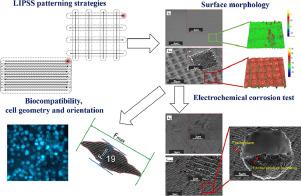Surfaces and Interfaces ( IF 6.2 ) Pub Date : 2022-09-21 , DOI: 10.1016/j.surfin.2022.102365 Muhammad Saqib , Natalia Beshchasna , Riccardo Pelaccia , Anton Roshchupkin , Ilya Yanko , Yevhenia Husak , Sergiy Kyrylenko , Barbara Reggiani , Gianaurelio Cuniberti , Maksym Pogorielov , Joerg Opitz , Leonardo Orazi

|
Laser-Induced Periodic Surface Structures (LIPSS) holds great potential for regenerative biomedicine. Creating highly precise LIPSS enables to generate biomimetic implant surfaces with improved properties. The present study focuses on the fabrication and investigation of laser-treated stainless steel samples with applied linear LIPSS patterns with grooves made by means of a picosecond laser system using wavelengths of 1064 nm and 532 nm. To investigate properties of the laser-treated surfaces and to understand the basics of cell-surface interactions between the LIPSS and human Umbilical Cord Mesenchymal Stem Cells (UCMSC), flat stainless steel samples with various applied nanopatterns were used. Such LIPSSs demonstrated higher surface roughness, good biocompatibility, lower wettability and higher corrosion resistance compared to the untreated (polished) specimens. The surface roughness of laser-treated samples was in microscale that enabled adhesion and migration of endothelial cells, thus increasing the likelihood for endothelialisation. This thereby could reduce the chances for the development of Late Stent Thrombosis (LST) and In-Stent Restenosis (ISR). Furthermore, laser textured surfaces demonstrated an environment supportive for cell attachment, proliferation and alignment with the nanogroves. Therefore, application of the biomimetic nanopatterns could help to overcome frequent post-surgery complications after the stent implantation.
中文翻译:

通过激光诱导周期性表面处理定制不锈钢的表面特性、生物相容性和腐蚀行为以开发仿生支架
激光诱导周期性表面结构 (LIPSS) 在再生生物医学方面具有巨大潜力。创建高精度 LIPSS 可以生成具有改进特性的仿生植入物表面。本研究的重点是制造和研究具有应用线性 LIPSS 图案的激光处理不锈钢样品,该样品具有通过使用 1064 nm 和 532 nm 波长的皮秒激光系统制成的凹槽。为了研究激光处理表面的特性并了解 LIPSS 和人脐带间充质干细胞 (UCMSC) 之间细胞-表面相互作用的基础知识,使用了具有各种应用纳米图案的扁平不锈钢样品。这种 LIPSS 表现出更高的表面粗糙度、良好的生物相容性、与未经处理(抛光)的样品相比,润湿性更低,耐腐蚀性更高。激光处理样品的表面粗糙度是微尺度的,这使得内皮细胞能够粘附和迁移,从而增加内皮化的可能性。因此,这可以减少发生晚期支架血栓形成(LST)和支架内再狭窄(ISR)的机会。此外,激光纹理表面展示了支持细胞附着、增殖和与纳米树对齐的环境。因此,仿生纳米图案的应用有助于克服支架植入后常见的术后并发症。从而增加内皮化的可能性。因此,这可以减少发生晚期支架血栓形成(LST)和支架内再狭窄(ISR)的机会。此外,激光纹理表面展示了支持细胞附着、增殖和与纳米树对齐的环境。因此,仿生纳米图案的应用有助于克服支架植入后常见的术后并发症。从而增加内皮化的可能性。因此,这可以减少发生晚期支架血栓形成(LST)和支架内再狭窄(ISR)的机会。此外,激光纹理表面展示了支持细胞附着、增殖和与纳米树对齐的环境。因此,仿生纳米图案的应用有助于克服支架植入后常见的术后并发症。


























 京公网安备 11010802027423号
京公网安备 11010802027423号